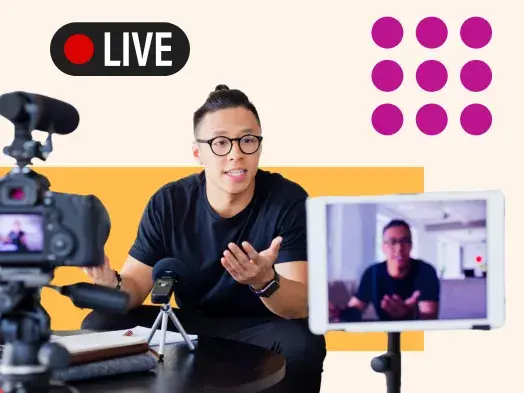How To Get More Views on YouTube For Free
Getting views on YouTube takes time and effort. But, if done right, it pays off (Forbes estimates that you can make anywhere from $3-$5 per 1000 views). Below, we’ll go over a few ways to get more views on your YouTube account.
1. Be mindful of SEO and organic search results.
YouTube is the second most popular search engine in the world, only topped by Google. To get more views on YouTube, follow the same SEO tactics you use to surface your content in organic Google search queries.
Since Google owns the platform, YouTube has similar algorithms for displaying the most relevant content. The video below goes into detail, but the tips that follow highlight the best steps you can take to obtain more views.
2. Use keyword-rich descriptions.
Your viewers initially see the first 100 characters of your video descriptions (example below), so you should aim to use keywords in snippets that provide the most relevant explanations to your viewers.

But using your keywords doesn’t mean an excuse to be dull. Get creative with your descriptions and aim to stand out. After all, the goal is to entice users to view your videos over your competitors.
Your first 100 characters should also entice users to click ‘Show more’ to learn more about what you have to say.
3. Use business-relevant tags.
YouTube’s algorithm determines 70% of what people watch on the platform. Using relevant tags for your business is key to surfacing your content in search results and obtaining more views.
Opt to use a combination of long-tail and short-tail keywords that truly relate to your video, listing the most important keywords first. Be mindful of keyword stuffing, as it is against YouTube policy and doesn’t help you generate more views.
4. Create unique, enticing titles.
Video titles are what people read first when browsing search results. So, aim to create compelling, unique video titles that clearly describe your video’s content and make people curious and interested in learning more. For SEO results, you can include your most relevant keyword in your video title.
Be mindful of clickbait, though, when creating your titles. It can be a valuable tool for getting users to click on your videos (see this article from a HubSpotter who was effectively clickbaited), but it can also backfire.
You don’t want to say your videos will be about one thing and have interested users find that you don’t touch on it at all. Ensure that your titles align with your content.
5. Use creative, relevant thumbnails.
Just as titles are the first exposure to your video content, thumbnails are the first images. Creating thumbnail previews that are exciting but relevant to your content is an excellent strategy for driving views. High-quality, engaging thumbnails can attract users in organic search results.
Your thumbnails can be screencaps from your videos or even text-based titles. Here’s an example of a thumbnail from popular YouTuber Marques Brownlee. He’s effectively created a thumbnail that depicts the content of the video: reactions to upcoming Apple product rumors.

6. Use closed captions and transcripts.
Subtitles and closed captions are another way to optimize your video SEO, as they highlight additional keywords and phrases for the algorithms to detect when indexing your videos.
Most importantly, closed captions and video transcripts make your YouTube account more accessible. If you solely rely on audio and visuals, you’re probably going to lose a large portion of your audience that’s unable to interact with your content in that form. When you create content that is accessible, all audiences can enjoy what you have to offer.
You should also opt for using closed captions instead of subtitles, as closed captions include dialogue and additional sound descriptions for actions like laughter or closing a door. Here are some resources that can help with understanding web accessibility and how to align your content with accessibility standards:
- Bureau of Internet Accessibility - Closed Captioning Guide
- Accessible Media Inc. YouTube Accessibility guide
- Google Accessibility Resource Database for Developers and Publishers
7. Encourage subscribers
While organic search results can be great, the algorithms won’t always surface your videos. Encouraging viewers to subscribe to your channel is another way to ensure that people can see your videos.
This means that when you post, your videos will show up in their subscriptions tab (shown below).

In addition to encouraging subscribers, ask users to turn on post notifications to get notified when you post a video.
Notifications can be a valuable tool for generating excitement. Users may feel they want to stop what they’re doing to watch your videos so they can actively participate in conversations about your content.
8. Repurpose your existing quality content.
Content repurposing is re-using existing content and presenting it in a new format to prolong its shelf life. Repurposing could mean creating a video from a high-performing how-to blog post (the bonus here is that YouTube users love how-to videos) or posting recording sessions from a popular podcast episode.
You’re repurposing helpful content and sharing it with a new audience in a format you know they enjoy.
9. Create a unique introductory hook for your videos.
It’s a unique tip, but it’s worth considering as many popular creators use this strategy.
Mr. Beast is a famous YouTube persona with almost 52 million subscribers. Each one of his videos begins with a clip of an exciting moment that doesn’t usually play out until at least halfway through the video.
Users must keep watching to see the moment unfold. Here’s an example:
10. Create a playlist.
If you create content clustered around a relevant, related topic, create playlists to encourage video views. The image below shows the playlists on the HubSpot YouTube account, where videos are organized by topic.

Playlists default to autoplay, so users can watch an entire playlist without taking action themselves.
Playlists and autoplay allow your users to view subject-relevant content that they may not have found themselves. This gives them a well-rounded experience and increases your video views.
11. Lead users to other videos in end screens.
End screens are the final 15-20 seconds of your video, sometimes called credits, used to recommend additional content on your channel as cards. Below is an example from the HubSpot YouTube account.

Your end screens can feature cards for single videos or entire playlists, a subscribe button, links to your associated websites, or secondary channels your business has (we’ll touch on this below.) It’s important to note that end screens should recommend relevant content.
12. Enable embedding.
Almost anything can be embedded these days, including YouTube videos. If you’ve created a YouTube strategy, you’ve likely identified your target audience on the platform. They’ll probably give you the most views, but enabling embedding can help you introduce yourself to additional viewers that may not have known your content would be relevant to them.
Here’s an example of a YouTube video embedded in a blog post.

You can embed your videos in your content, like blogs and email newsletters, but it’s also a valuable way to expose your content to new audiences.
Other people can embed your content within their own pages and share your expertise with their audiences. These views still count towards your overall view count, even if they’re not on YouTube.
13. Promote videos on other platforms.
YouTube probably isn’t your only social media profile, and you should use this to your advantage. Share new video announcements on your Instagram Stories, share links and clips on Twitter and Facebook, and share them in your blog posts and emails.
You’ll expose new audiences to your content, and, as mentioned above, views on other platforms count towards your YouTube view count.
14. Leverage current trends.
Leveraging YouTube trends is a valuable tool for obtaining more video views. This doesn’t necessarily mean that you should create content that is exactly in line with a current, trending meme on YouTube, but you should pay attention to what types of videos get lots of views.
For example, Mediakix released a list in 2019 of the most popular types of videos. Among them are how-to and Q&A videos.
Suppose you’re a business hoping to utilize one of these trends. You could create a how-to video demonstrating how to use your product or service and a Q&A video where you troubleshoot consumer inquiries. You’re creating content that users want to see that provides value to them to generate more views.
15. Focus on creating relevant content.
Leveraging trends is important for generating views, but you shouldn’t abandon your topic type to get views.
A YouTube channel filled with unrelated content can generate views but won’t be seen as a source of authority. Your content would be scattered, users might write you off, and algorithms won't know your niche. So, the two tips come together to leverage current trends to create content that aligns with your existing strategy.
Also, relevant content outweighs video quality. YouTube found that, when deciding what to watch, content relating to a user's passions is 1.6x more important than the video’s quality (like visuals and camera quality), and 3x more important than whether it features well-known actors.
This means that the most valuable content you can create isn’t expensive and high budget — it’s content that’s in line with your audience's needs. When you understand what they want, it’ll be easier to earn views.
16. Collaborate with similar accounts.
One of the exciting aspects of YouTube is its community. There are people creating all different types of content, from gaming videos to exercise classes. You’ll likely find people who make content like yours, and collaborating with them is a valuable tool for generating more views.
Collaborations usually involve creating two separate videos, one for your channel and another for the collaborators’ channel. When they’re posted, you’ll gain exposure to their audience group and them from yours.
If you’ve collaborated with a topic-relevant channel, new viewers will likely already be interested in your content and may even subscribe to your channel. It’s also a valuable way to create more content, and more content always inspires more views.
17. Post at the right time.
There is a right time to post on YouTube. The best times to post on YouTube are Thursday or Friday afternoons between 12:00 and 3:00 PM, and on Saturdays between 9:00 and 11:00 AM.
You can certainly leverage these numbers and obtain views, but it’s also essential to create a posting schedule that aligns with your existing viewership.
You can get this information from YouTube’s native analytics tool or your preferred service. If you’re a HubSpot user, you can connect your YouTube account to Marketing Hub and generate custom reports.

Posting at the right time translates into views, because your subscribers are more likely to watch during a time that they’re free versus when they’re at work.
18. Use a multi-channel approach.
If you’re a large business, consider creating multiple YouTube channels for different purposes. For example, HubSpot has five separate YouTube channels (shown below) tailored to different audience groups.
Multiple channels ensures that content is accessible to different viewers, and it generates more views.
This isn’t just a HubSpot thing — Interbrands says that the top 100 brands on YouTube have an average of 2.4 channels.
19. Optimize for mobile viewers.
More than 70% of YouTube watch time comes from mobile devices, so create content that these audiences can enjoy.
Optimizing for mobile viewers means creating videos that can adapt to different mobile device aspect ratios, video titles and thumbnails that don’t get distorted on smaller devices, and recommend videos in end-screen cards.
20. Remember to be patient.
As marketers, we all want virality and immediate success for the content we create. While you may sometimes get lucky, generating more YouTube views takes time and patience.
There’s not much concrete advice to give with this tip, but understand that if you’ve leveraged the tips on this list, you’ll likely gain more views to begin growing your channel.
Next, we’ll go over how to keep growing your channel after reaching your first 1000 views on YouTube.
How To Reach 1000 Views on YouTube and Keep Growing Your Channel
Although it certainly would be nice, there is no equation to help you generate your first 1000 views on YouTube. Some people gain instant success, while others struggle to reach even 100 views after making hundreds of videos. In fact, 88.4% of YouTube videos generate fewer than 1000 views.
This may be discouraging to hear, especially since you can only begin to monetize your videos on YouTube after having more than 4,000 public watch hours. Many creators, including Zac Snyder, have attempted to figure out the perfect formula.
Snyder highlighted his mathematical approach in a Medium article recommended that a good start could be to make 300 videos a year at 10 minutes a piece. However, this strategy may not work for all creators.
There are ways to generate more views sooner rather than later. First, you should use and reference the tips mentioned above when creating your videos. There are also four additional tips to consider to continue growing your YouTube channel after reaching 1000 views.
1. Increase your upload frequency.
If it’s taken you a long time to reach 1000 views, it may make you nervous to risk your viewership by doing anything differently. However, it's easier to generate more views with more videos than to generate more views from one or two standalone videos.
Pay attention to your channel analytics, understand when you generate the most views, and increase your upload frequency to match your engagement metrics.
Once you’ve developed a schedule, identify time frames in which you’ll reassess your strategy. For example, maybe you’ll aim to upload three times per week until you reach 10k views, and then you’ll analyze your metrics and switch to uploading twice a week.
2. Keep introductions and opening credits short and to the point.
Attention spans are short, so any unnecessary content in your videos can cost you viewers. Once you’ve reached 1000 views and generated an audience, you don’t want to lose them.
Use analytics to understand their behavior and adjust accordingly. If viewers seem to stop watching after a certain amount of time, consider shortening your introductions so viewers get to the core of the content faster and feel more inclined to finish the video.
3. Optimize for ‘Suggested Video’ views.
Suggested videos show up in the sidebar of a desktop YouTube screen, as shown below in the red outline.

The algorithm recommends videos based on tags, so choose industry-relevant tags that your competitors are also using. When they match, you have a significant chance of showing up in suggested videos for the same tags.
YouTube also doesn’t discriminate by subscriber count, so even if you don’t have as many subscribers as your competitors, it's still possible to be suggested after their videos.
4. Engage with subscribers in the ‘Community’ tab.
The Community tab is built for YouTube creators hoping to interact with their audience outside of their video comments. You can create polls, feature images, and generate hype for upcoming videos.
Post snippets to get subscribers excited about what’s to come, and they’ll likely be looking out for your video and ready to watch when it goes live.
If you’re interested in learning more in-depth strategies for growing your channel, check out this HubSpot Academy YouTube Course featured resource. You’ll learn how to build your brand, develop an audience, and gain insight from YouTube influencers on creating a successful channel.
Create Content That Inspires Subscribers and Encourages Views
You’re creating YouTube videos because you know you can provide value to your audience.
Remember, it may be frustrating if results aren’t immediately significant. But if you optimize your videos and channel for SEO, create consistent, relevant content, and engage with your audience, you’ll not only reach 1000 views but own a channel that just keeps on growing.
Youtube Marketing






![13 YouTube Description Templates That Have Helped Our Videos Go Viral [+ Examples]](https://53.fs1.hubspotusercontent-na1.net/hubfs/53/youtube-description-template_8.webp)
.jpg)
![Best Times to Post on YouTube in 2025 [Research]](https://53.fs1.hubspotusercontent-na1.net/hubfs/53/best-time-to-post-youtube.jpg)




